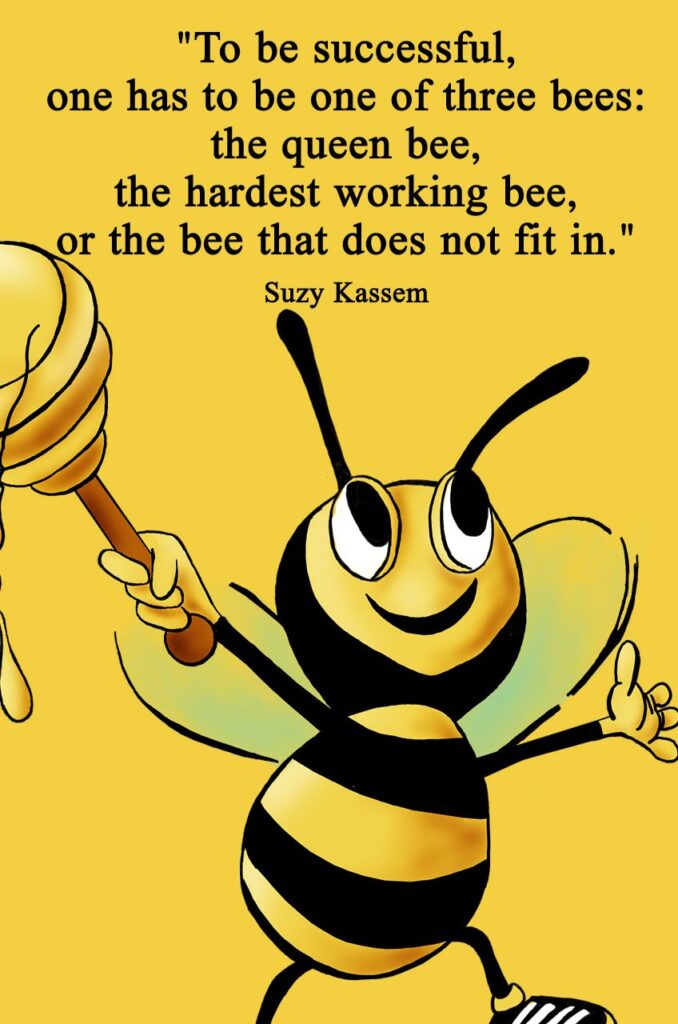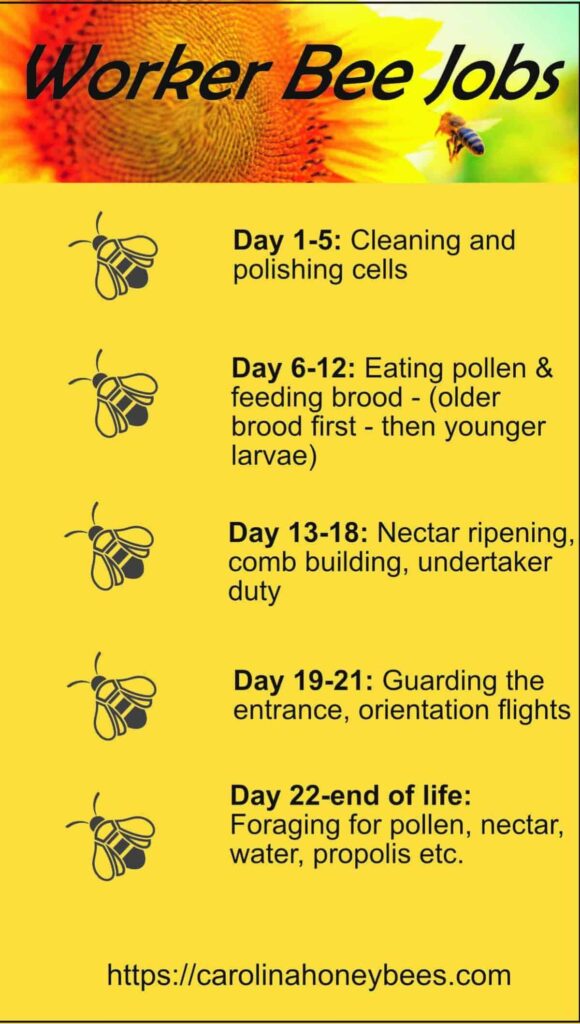
In the intriguing world of worker bees, their roles extend far beyond just buzzing around flowers. These industrious insects play a pivotal role in maintaining the hive, from tending to the queen and her offspring, to gathering nectar and pollen to sustain the colony. With each bee fulfilling a unique set of responsibilities, this article peels back the curtain to uncover the many fascinating roles worker bees undertake within their bustling society.
Foraging for Food
Collecting Nectar
As a worker bee, one of your important roles is to collect nectar for the hive. Nectar is a sugary liquid produced by flowering plants, and it serves as a vital source of energy for the colony. To collect nectar, you visit various flowers and use your long, tubelike tongue called a proboscis to suck it up. You then store the nectar in your honey stomach, which is separate from your regular stomach.
Gathering Pollen
In addition to collecting nectar, gathering pollen is another crucial task you undertake as a worker bee. Pollen is a fine, powdery substance produced by the male parts of flowering plants. It contains essential nutrients that are necessary for the development of the brood. You have specialized structures on your legs called pollen baskets or corbiculae, which allow you to carry the pollen back to the hive. As you visit flowers, pollen sticks to the hairs on your body, and you brush it into your pollen baskets to transport it safely home.
Water Collection
Water is also an essential resource for the hive, and you play a part in ensuring its availability. While collecting nectar and pollen, you actively seek out water sources to bring back to the hive. Water serves various purposes, such as diluting honey, maintaining hive humidity, and cooling the hive temperature. You drink water from ponds, puddles, or other sources and transport it back to the hive using your specialized mouthparts. Your ability to collect water efficiently contributes to the overall health and survival of the colony.
Building the Hive
Constructing Honeycomb
Another crucial responsibility you have as a worker bee is to construct honeycomb. Honeycomb is a series of hexagonal cells made from beeswax, a substance secreted by worker bees. These cells serve as storage units for food, including nectar, pollen, and honey. They also provide a platform for the queen to lay her eggs. As a skilled builder, you shape the wax into intricate hexagons, utilizing the most space-efficient design for storage.
Sealing Cracks and Openings
Maintaining the structural integrity of the hive is essential, and as a worker bee, you play a vital role in sealing cracks and openings. By using a gland in your abdomen, you produce propolis, a sticky substance made from plant resins. Propolis acts as a natural sealant, closing gaps and reinforcing weak areas within the hive. This sealing helps regulate temperature and keeps out potential intruders, making the hive a safe and secure environment for the colony to thrive.

Nurturing the Brood
Feeding Larvae
One of your most nurturing responsibilities is feeding the young larvae in the hive. After the queen lays her eggs, you diligently work to provide them with the nutrition they need to develop into healthy adult bees. You secrete a substance called royal jelly, which is highly nutritious and essential for the growth of the larvae. By feeding them royal jelly, you ensure their proper development and increase their chances of becoming strong members of the colony.
Attending to the Queen
The queen bee is the heart of the hive, and her well-being is crucial for the survival of the colony. As a worker bee, you attend to the queen, catering to her every need. You groom her, ensuring her cleanliness and removing any dirt or debris from her body. You also feed her with royal jelly, providing her with the necessary nutrients to maintain her queenly status. Your care and attention to the queen contribute to the overall harmony and productivity of the hive.
Maintaining Hive Cleanliness
Removing Waste
Maintaining a clean and hygienic hive is essential for the health and well-being of the colony. As a diligent worker bee, you actively participate in waste management within the hive. You carry out the task of removing waste such as dead bees, debris, and excess pollen from the cells. By keeping the hive clean, you prevent the spread of diseases and ensure a healthy environment for the entire colony.
Ventilation and Temperature Regulation
Proper ventilation and temperature regulation are vital for the well-being of the hive, particularly during hot summer months or cold winter days. As a worker bee, you contribute to these processes by actively flapping your wings to circulate air and maintain optimal temperature inside the hive. By controlling the airflow, you ensure the comfort of the colony and prevent the build-up of excess heat or cold.

Guarding the Colony
Protecting the Hive Entrance
Ensuring the safety and security of the colony is one of your primary responsibilities as a worker bee. You stand guard at the hive entrance, diligently monitoring any activity in and around the hive. Your keen eyesight and ability to identify potential threats help you discern between intruders and fellow bees. You take proactive measures to defend the hive, such as stinging intruders to protect the colony’s precious resources and the safety of your fellow bees.
Defending Against Intruders
Despite your efforts to protect the hive entrance, intruders may occasionally attempt to invade the colony. As a worker bee, you collaborate with your sisters to engage in collective defense. When an intruder is detected, a signal is quickly spread throughout the hive, alerting all bees to unite in defense. By attacking and stinging together, you ward off potential threats and protect the colony with unwavering determination.
Communication and Navigation
Dancing to Communicate Locations
Communication is crucial for the efficient functioning of the hive, and you employ a unique dance language to convey important information to your fellow bees. Through a series of intricate movements known as the waggle dance, you communicate the location of rich nectar sources or suitable sites for new beehives. By sharing this valuable information, you ensure that the colony maximizes its foraging efforts and thrives in its environment.
Using Pheromones as Signals
In addition to dancing, pheromones are another powerful tool you use for communication within the hive. Pheromones are chemical signals that you produce and release, conveying crucial information to your sisters. For example, you release an alarm pheromone when you detect danger, which alerts other bees to the presence of a threat. By utilizing pheromones, you establish a strong communication network that enables efficient coordination and decision-making within the colony.
Orientation and Navigation
Finding your way back to the hive after foraging for food can be challenging, but as a worker bee, you possess remarkable navigation skills. You rely on multiple cues, such as the position of the sun, landmarks, and the Earth’s magnetic field, to orient yourself and navigate accurately. By using these celestial and environmental cues, you successfully return to the hive, bringing back the valuable resources you gathered to support the hive’s needs.

Regulating Hive Population
Identifying and Removing Drones
Maintaining an optimal population within the hive is crucial, and as a worker bee, you participate in regulating the number of drones (male bees) present. Drones have a limited role and consume valuable resources, so you help identify and remove them when their presence exceeds the hive’s needs. By controlling the drone population, you ensure that resources are efficiently allocated and that the hive remains balanced.
Supporting New Queens
When it is time for a new queen to emerge, you play a pivotal role in supporting her journey to adulthood. You construct special queen cells from beeswax, providing a secure environment for the developing queen. You feed the queen larvae with an abundance of royal jelly, ensuring their proper nutrition and growth. By nurturing new queens, you ensure the continuity of the hive and the potential for new colonies to thrive.
Producing Royal Jelly
Creating Nutritious Secretion
As a worker bee, you possess an extraordinary ability to produce a highly nutritious substance called royal jelly. Royal jelly is secreted from special glands in your head, and it serves as an essential source of nutrition for the queen, as well as the young larvae in the hive. The composition of royal jelly is rich in proteins, vitamins, and minerals, providing the necessary sustenance for proper development and vitality of the individuals within the colony.
Feeding the Queen
Among the recipients of your precious royal jelly, the queen bee holds a special place. You diligently feed her with this nutrient-rich substance throughout her life. The royal jelly you provide contributes to the queen’s tremendous size and reproductive capabilities, ensuring her longevity and ability to continue laying fertilized eggs. By nourishing the queen, you support the overall health and strength of the hive.

Temperature Control
Flapping Wings for Cooling
Maintaining the hive at an optimal temperature is crucial for the well-being of the colony. During hot summer days, you help cool the hive by rapidly flapping your wings, creating airflow that assists in dissipating excess heat. This active cooling process prevents the hive from overheating and ensures a comfortable environment for the bees.
Heating the Brood
Conversely, during colder periods, you play a role in keeping the developing brood warm. You use a technique called thermoregulation to generate heat by contracting your flight muscles while in contact with the brood cells. By shivering your muscles, you elevate the temperature around the brood, ensuring their proper development and increasing their chances of survival.
Honey Production
Ripening Nectar
Once you have collected nectar from flowers, the transformation into honey begins. As a worker bee, you help ripen the nectar by adding enzymes from your stomach to break down complex sugars into simpler ones. Through this enzymatic process called inversion, the nectar is gradually transformed into the sweet, viscous substance we know as honey.
Evaporating Water
To transform nectar into honey, the excess water content must be reduced. As a worker bee, you contribute to this process by fanning your wings and creating airflow around the open honeycomb cells. The air movement encourages water evaporation, gradually thickening the nectar and increasing its sugar concentration. Your efforts, combined with those of your fellow bees, result in the creation of the delectable honey that will serve as a vital food source for the colony.
Capping Honey Cells
Once the honey reaches the appropriate moisture level, you skillfully cap the honey-filled cells with beeswax. These capped honey cells serve as long-term food storage for the colony, ensuring a constant supply of sustenance during times when nectar may be scarce. Your meticulous work in capping the cells helps preserve the freshness and quality of the honey, ensuring its availability when the hive needs it most.
In conclusion, as a worker bee, your multifaceted roles are essential for the survival and prosperity of the hive. From foraging for food and building the hive to nurturing the brood and maintaining cleanliness, your tireless efforts contribute to the overall harmony and efficiency of the colony. Through communication, defense, and navigation, you uphold the unity and success of the hive. Your commitment to the tasks at hand ensures the well-being of the queen, the production of honey, and the continuous cycle of life within the bee colony.
